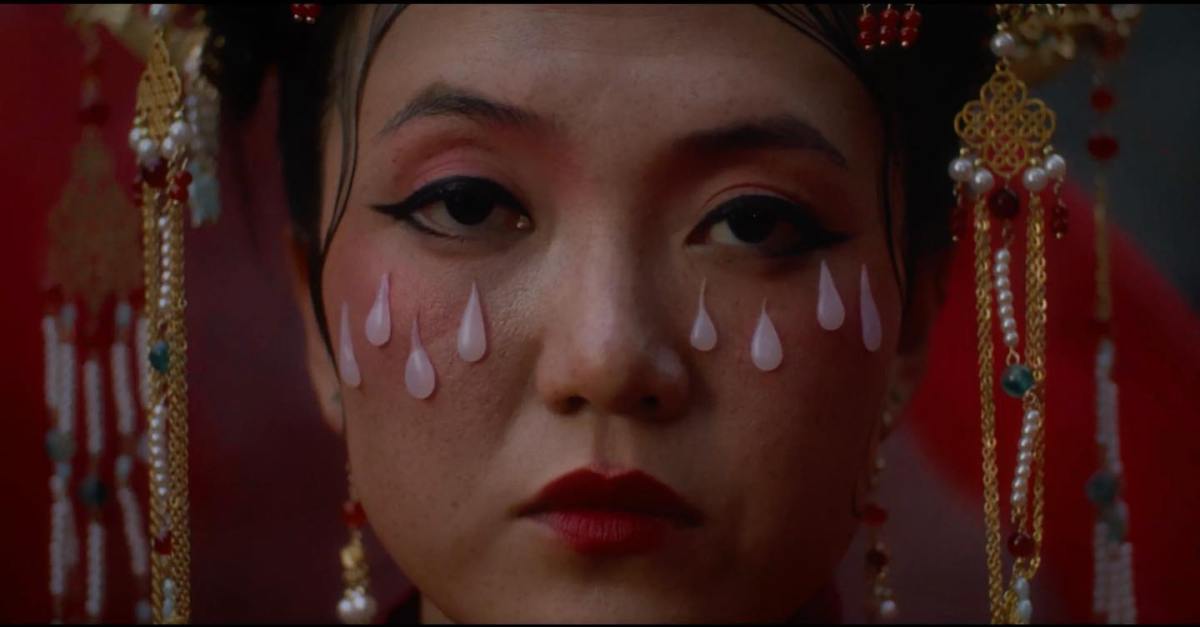Marriage, supposedly celebratory, marks a death for some. The Bridal Lament (哭嫁歌), directed by Tessa Leong, explored a dying ritual of lead artist and performer Rainbow Chan’s Weitou ancestry. Weitou, the earliest settlers of Hong Kong, was a highly patriarchal society where women entered an arranged marriage in adolescence. They would sing the bridal lament as they grieved the death of their personal identity.
Owing to Chan’s music-focused multidisciplinary practice, The Bridal Lament took the form of a theatrical mixtape. The performance was structured in episodes, with each representing a step of the Weitou tradition leading up to the arranged marriage. Every segment featured a description of the custom provided by Chan’s mother in a blend of Weitou dialect and Hong Kong Cantonese, followed by Chan’s performance of the bridal lament and an original song.
Chan’s synthesised vocalisation of the bridal lament was nicely complemented by earthy imagery, designed by Rel Pham. Despite being tied to a sorrowful ritual, it was poetic and meditative. Chan’s energetic performance of her pop-style original songs created an immediate contrast.
During her monologue Chan said: ‘The bridal lament is an act of defiance even when fate is sealed.’ Her lyrics and movement materialised the internal rebel lying within the mellow traditional tune, seeking freedom and hope in the cage of social constraints. The choreography was electrifying. It rhythmically portrayed the strength and flexibility of a woman. Though Chan’s dancing was captivating; however, it detracted from her vocal ability and articulation. The songs would make for a wonderful concept album but, in combination with Chan’s mother’s description of the bride-to-be’s feelings, at times they felt repetitive.
Between episodes, Chan offered a brief insight into her exploration of cultural identity. Her experience as an Asian Australian migrant child resonated with culturally diverse audience members, earning her a few laughs in agreement. Her humorous delivery was refreshing in a heavy piece about women’s rights. She also emphasised the importance of cultural preservation by revealing how the development of this production had helped her connect to her ancestors. While her monologues declared the significance of the project, the snippets of her life were inserted in the narrative of the wedding tradition in a way that disrupted the flow of the show. It was unclear how the individual stories related to the segment before or after them.
Read: Dance review: tiaen tiamen Episode 1, Dunstan Playhouse
A commendable highlight of this production was certainly the crystal installation, designed by Al Joel and Emily Borghi, which resembled the sedan chair brides would sit in while being carried to the groom’s house. It was an excellent modern interpretation, and particularly mesmerising when projection-mapped with abstract video art.
The Bridal Lament was an ambitious work infused with vulnerability, grief and empowerment. Though inspired by extinct customs, it reminded audiences of the women and girls who are still forced into arranged marriages around the world. The past is present and future; we are connected to history and we are one with the women who mourn.
The Bridal Lament
Lead Artist and Performer: Rainbow Chan
Director: Tessa Leong
Choreographic Consultants: Amrita Hepi and Victoria Hunt
Cultural Consultant and Narrator: Irene Cheung 張翠屏
Video Programmer: Daniel Herten
Video Design: Rel Pham
Set Design: Al Joel and Emily Borghi
Costume Design: Al Joel
Lighting Concept: Govin Ruben
Lighting Realisers: Susie Henderson and Sam Read
The Bridal Lament, co-commissioned by OzAsia Festival and Performance Space, was performed at the Space Theatre on 1 and 2 November.
This review is published under the Amplify Collective, an initiative supported by The Walkley Foundation and made possible through funding from the Meta Australian News Fund.





